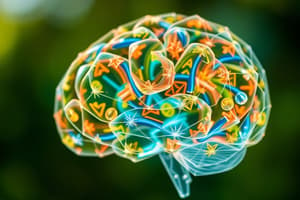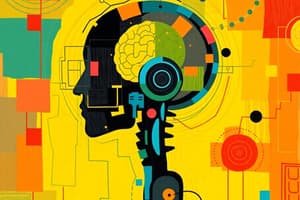Podcast
Questions and Answers
What distinguishes embodied cognition from traditional cognition?
What distinguishes embodied cognition from traditional cognition?
- It relies on separate mental representations.
- It emphasizes the role of sensory and motor systems. (correct)
- It considers interactions with the environment to be irrelevant.
- It is primarily focused on cognitive thoughts alone.
How does interaction with the environment affect cognitive processes in embodied cognition?
How does interaction with the environment affect cognitive processes in embodied cognition?
- It allows for changes in sensory signals that contribute to cognition. (correct)
- It has no effect since cognition is separate from the environment.
- It solely relies on visual representations.
- It only influences motor functions, not cognitive functions.
What is a key feature of how representations are stored in embodied cognition?
What is a key feature of how representations are stored in embodied cognition?
- They are scattered across motor and sensory systems. (correct)
- They are predominantly located in the visual processing areas.
- They are exclusively stored in the cognitive cortex.
- They exist only as abstract symbols in the mind.
Which statement is true regarding the concept of mental simulation in embodied cognition?
Which statement is true regarding the concept of mental simulation in embodied cognition?
What phenomenon illustrates the activation of representations in embodied cognition?
What phenomenon illustrates the activation of representations in embodied cognition?
What do body-mind effects suggest about the influence of holding objects during a task?
What do body-mind effects suggest about the influence of holding objects during a task?
In which experiment did subjects change their responses based on the presence or absence of a gun?
In which experiment did subjects change their responses based on the presence or absence of a gun?
What is the primary focus of mind-body effects as described?
What is the primary focus of mind-body effects as described?
What was the task assigned to subjects in Tucker & Ellis's experiment?
What was the task assigned to subjects in Tucker & Ellis's experiment?
How did the congruency of stimuli impact object recognition in Helbig et al.'s study?
How did the congruency of stimuli impact object recognition in Helbig et al.'s study?
What hypothesis is supported by the findings of embodied cognition?
What hypothesis is supported by the findings of embodied cognition?
What does the evidence from the experiments indicate about the relationship between body and mind?
What does the evidence from the experiments indicate about the relationship between body and mind?
What was the unique variable in Experiment 5 regarding the shoe perception bias?
What was the unique variable in Experiment 5 regarding the shoe perception bias?
Flashcards
Embodied Cognition
Embodied Cognition
The theory that cognitive processes are deeply linked to sensory and motor experiences, without separate mental representations.
Distributed Representations
Distributed Representations
In embodied cognition, representations are spread across sensory and motor areas of the brain, not isolated.
Mental Simulation
Mental Simulation
Embodied cognition suggests that thinking involves recreating perceptual and motor experiences.
Priming (Embodied Cognition)
Priming (Embodied Cognition)
Signup and view all the flashcards
Two-way Interaction (cognition)
Two-way Interaction (cognition)
Signup and view all the flashcards
Body-mind effects
Body-mind effects
Signup and view all the flashcards
Mind-body effects
Mind-body effects
Signup and view all the flashcards
Action observation
Action observation
Signup and view all the flashcards
Motor aspects of representation
Motor aspects of representation
Signup and view all the flashcards
Sensory aspects of representation
Sensory aspects of representation
Signup and view all the flashcards
Stimulus-response compatibility
Stimulus-response compatibility
Signup and view all the flashcards
Priming effect
Priming effect
Signup and view all the flashcards
Study Notes
Traditional vs. Embodied Cognition
- Traditional cognition proposes separate brain regions for thinking, seeing, and interacting with objects.
- Representations are stored apart from sensory and motor areas.
- Embodied cognition, conversely, suggests a close link between cognition and sensory/motor systems.
- Representations are distributed across sensory and motor regions.
- Mental simulation of perceptual and motor experience is central to this approach.
Priming and Representation Activation
- Embodied cognition posits that activating one part of an object representation automatically activates other parts.
- For example, reading "CAT" could potentially trigger the feeling of touching a cat.
Body-Mind Effects
- Witt & Brockmole (2012) found holding an object (e.g., gun or ball) during a perception task influenced how quickly subjects recognized a target stimulus.
- Holding a gun biased responses even when a gun wasn’t part of the direct response.
- This suggests that holding an object related to the task can physically bias visual recognition.
Mind-Body Effects
- Tucker & Ellis (2004) showed that perceiving an object's size influenced the grip strength used to judge it.
- Size and natural/man-made attributes of objects affected the efficiency of the response action.
- This demonstrated that object perception can activate related motor actions, affecting subsequent response actions.
Action Observation
- Helbig et al. (2010) investigated how observing an action can prime the recognition of objects associated with that action.
- Seeing a hand action and then a corresponding object influenced object recognition speed.
Summary of Embodied Cognition
- Cognition is deeply rooted in sensory and motor experiences.
- There's a strong overlap in neural structures for perception, action, imagination, and observation.
- Cognition is akin to mental simulation.
- There's two-way interaction between the body and mind.
- Bodily experience significantly impacts cognitive processes.
Studying That Suits You
Use AI to generate personalized quizzes and flashcards to suit your learning preferences.




